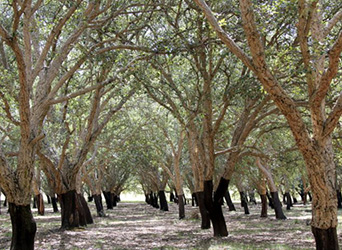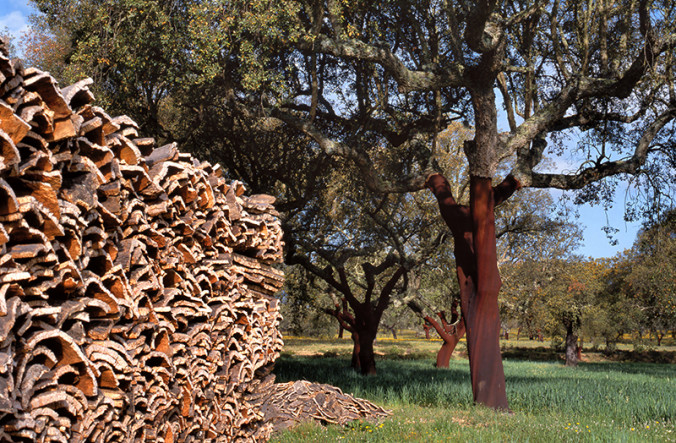Cork oak, Quercus suber a medium-sized, evergreen tree is the primary source of cork for wine bottle stoppers and other uses. It is native to southwest Europe and northwest Africa. It grows to up to 20 metres, although it is typically more stunted in its native environment.
Cork oaks commonly live more than 200 years. Cork harvesting is done entirely without machinery. The European cork industry produces 340,000 tonnes of cork a year, with a value of €1.5 billion and employs 30,000 people.
The cork is used to make a wide range of products in addition to wine bottle stoppers, including insulation panels, floor and wall tiles and sound-proofing in the car industry, as well as for handicrafts and artistic uses such as cork paper used in printing, book covering, clothing manufacture, cork maroquinerie and other products. Cork is also used in making cricket balls, badminton shuttlecocks and handles of fishing rods.
Cork is also used for fridge insulation, engine gaskets, cork tiles, fishing nets, shoe heels, bulletin boards, woodwind instruments and model trains.
Cork oak trees do best in a moist maritime environments with hot summers, typical of the lower slopes of hills around the western Mediterranean. From the Atlantic coast to Italy and from Algeria to Tunisia, cork forests cover about 26,000 square kilometres although more than half of the world’s cork comes from Portugal, with most of the rest from Spain.
According to Pliny the Elder, Roman woman of his day appreciated the insulation and lightness of cork-soled sandals as much as the extra height it gave them. In fact, having evolved to protect trees from fire, cork’s thermal insulation is so good that it has been used to shield the fuel tanks on NASA’s space shuttles.
The bark of cock oak is adapted to defend trees from fungi and microbes and is exceptionally impermeable even to air, and almost completely inert. No other untreated, naturally occurring plant product can remain unchanged in contact with so many substances. It is resistant to water, petrol, oil, and of course alcohol. Its cells can withstand extreme compression while retaining their springiness – perfect for squeezing tightly into the neck of a wine bottle. As a bonus, when cork is cut lots of microscopic cups are formed, and those myriad tiny vacuums prevent corks from slipping from smooth glass bottle necks.
The cork oak is rare in being so willing to regenerate its bark, which can be harvested once the tree is about 20 years old and then repeatedly about every decade. The bark is stripped from the trunk in late spring up to a height of about 2.5 metres and from sections of larger branches.
Australia has an interesting cork oak connection. At the northern end of the National Arboretum in Canberra is a 100 year-old cork oak plantation established many years before the National Arboretum was created.

100 year-old cork oak plantation at the northern end of the National Arboretum in Canberra.
At the time, city planner Walter Burley Griffin and Charles Weston, the officer in charge of forestry for Canberra, were looking to trial different tree species. Griffin saw the potential for growing cork oaks in Canberra’s dry climate, and sourced the initial acorns from the Royal Botanic Gardens in Melbourne. The acorns were propagated at the newly established Yarralumla Nursery, and they were planted in October 1917.
The demand for cork was growing and a second consignment of acorns destined for Canberra was gathered in Spain. “However, this particular consignment never actually made it, as the ship carrying the acorns was torpedoed during the First World War and about 30,000 acorns were lost at sea,” said Scott Saddler National Arboretum manager.
